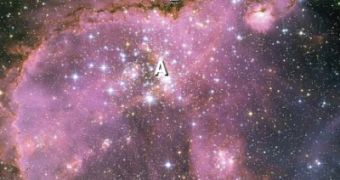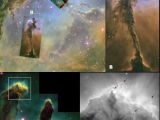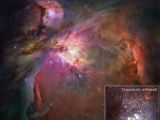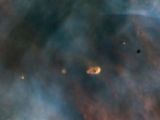Once Newton's theory of gravitation was in place, people started creating models of how the solar system must have been born. The most renowned such theory is the one invented by Kant and Laplace in the second half of the 18th century and which still holds to this day, greatly improved by new discoveries regarding the process by which a star is ignited.
The theory states that particles of dust and gas accumulate due to the gravitational attraction; most of this material ends up in a single body - the future star. Although, initially, the particles can move in any directions, eventually, as they collide or fly by each other, one general rotational motion gradually takes hold. This is called a protoplanetary disks or "proplyd".
Most of this material gets packed into a single body that becomes so dense that it ignites: atoms (especially hydrogen atoms) get smashed into each other and transformed into other atoms (such as helium) and light. This process is called fusion and it is the process by which the star produces the light we see. The star does not collapse any more because the fusion process creates a reverse force that balances the gravitation. A star similar in size to our Sun continues to fuse its hydrogen atoms for about 10 billion years.
Sometimes, instead of just one star, two or even three stars appear. The rest of the material, the debris that didn't got caught in the star itself (or stars), amasses in the form of the planets.
Today, this theory is no longer just a story, as astronomers have observed in various parts of the sky various "stellar nurseries" called dark nebulae. We are able to see these clouds of dust where stars get formed because they are illuminated from behind by other stars. Here are three of the most spectacular discoveries made by Hubble Space Telescope.
The NGC 346 nebula in the Small Magellanic Cloud
The Magellanic Clouds are two small satellite galaxies of our galaxy, the Milky Way. This image illustrates three stages of star formation: The darker region above the ridge B contains yet unborn stars.
The bright blue stars that can be seen in the region A, below the ridge B, are very young, massive and hot. They are only about 3 to 5 million years old. They emit large amounts of ultraviolet light that is destroying the cloud that has been their stellar nursery and creates the ridge B.
This ridge is formed from denser gas and dust and is "eroded" by the outflow of energy from the nearby, hot, young stars. The beautiful pink color in the image is caused by the energized gas of the nursery: the ultraviolet light heats the gas and makes it glow.
Thus, we are witnessing here a dark cloud of dust and gas that spawns stars, and as the stars are born the entire nebula is lit up and gradually dispersed. As time passes, the entire cloud will be heated. Without any cold gas, star formation will cease.
This is what happened in the lower portion of the image, C. The stars in that cluster are about the same age as our Sun, around 4.5 billion years old. We know this because we can see their color: most of them are yellow stars. The larger, hotter stars are blue and they exhaust their energy much more quickly. As a result, in the region C only the smaller, Sun-like, stars have remained.
Thus, NGC 346 is a picture of star formation and development: we can see the dark clouds where stars are born, their emergence as young stars, and finally their passage into maturity. Credit: NASA, ESA, and the Hubble Heritage Team (STScI/AURA).
The Eagle nebula
This is one of the most famous pictures taken by Hubble. In the first detail view, region A, we can see three columns of dust and gas (mostly hydrogen) illuminated by the young, hot, massive stars on top of the pillars. In the zoomed region these stars are indicated by arrows.
The stars' intense radiation heats the surrounding gas, making it glow. Moreover, this radiation is responsible for "sculpting" the columns through a process called photoevaporation - the light pushes away the feeblest particles and leaves behind only the larger conglomerates, denser gas globules called EGGs (Evaporating Gaseous Globules).
Photoevaporation in the Eagle Nebula has cut newly forming stars off from the cloud feeding them. While some of the EGGs are large enough to eventually become stars, others may never make it.
In the second detailed view, B, we can see another stellar nursery (see larger image). The odd-looking tower is 9.5 light-years (or about 92 trillion kilometers) high, more than twice the distance from our Sun to Alpha Centaury (the nearest star).
This giant cosmic sculpture is created by the ultraviolet light coming from the newborn stars. The stars at the top of the tower heat the gas creating the wing-like features. They also create a shock front that pushes against the darker cold gas and that will move down across the tower. Insofar it has just started, lighting up the "wings". This intense pressure compresses the gas, making it easier for stars to form.
The threads of material in the center of the tower are also stellar birthing areas. They are roughly the size of our solar system. In this portion of the tower the formation of stars prevents other stars from forming because the light of the newborn stars is pushing away the gaseous material, dispersing it.
From the color of the glowing gases scientists can deduce the chemical composition. The blue color at the top reveals the presence of oxygen while the red color in the lower region is from glowing hydrogen.
The Orion nebula
The Great Nebula in Orion, located in the same spiral arm of our Galaxy as our Sun, 1500 light-years away from us, is one of the most interesting of astronomical nebulae known. The filamentary structure visible in this image is caused by shock waves.
The bright cluster of stars in the center, called the Trapezium, is responsible for most of the illumination in the nebula. The five brightest stars in the Trapezium have masses on the order of 15-30 times that of our Sun. When astronomers used Hubble's near-infrared camera to see though the cloud of dust they uncovered a swarm of newborn brown dwarfs (the smallest type of stars that can barely fuse deuterium and lithium, but not hydrogen).
The Orion Nebula also contains many stellar nurseries. Astronomers have observed approximately 700 stars in various stages of formation within the nebula.
A close-up view of a small portion of the nebula has revealed the image below of four stars surrounded by gas and dust, which are considered to be systems in the earliest stages of solar system formation. (Credits: C.R. O'Dell (Rice University), and NASA.) These so-called "proplyds" will evolve on to agglomerate into planets. Astronomers have discovered more than 150 such proplyds, an indication that the formation of solar systems is a fairly common phenomenon.

 14 DAY TRIAL //
14 DAY TRIAL // 


